Basics
Elephant seals are pinnipeds
Inside this section
• Pinnipeds
• True seals vs. sea lions
• Two species
________________________________

Pinnipeds are carnivorous marine mammals with fin-like limbs. They breathe air like humans and other mammals, reptiles and birds, but they spend most of their time at sea.
Pinnipeds include "true seals", sea lions, fur seals and walruses. Elephant seals are the largest of the true seals.
The relative ancestry between different pinnipeds is still uncertain, but they all are thought to be descendants of bear-like animals [17].
See elephant seals
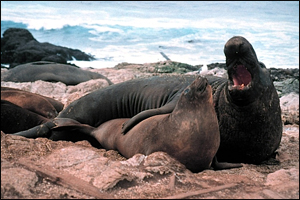 Click on image to see slides.
Northern elephant seals, Mirounga angustirostris.
The smaller seal is an adult female and the much larger one with the trunk-like nose is an adult male. Elephant seals exhibit sexual dimorphism - a systematic difference in form between individuals of opposite sex of the same species.
Click on image to see slides.
Northern elephant seals, Mirounga angustirostris.
The smaller seal is an adult female and the much larger one with the trunk-like nose is an adult male. Elephant seals exhibit sexual dimorphism - a systematic difference in form between individuals of opposite sex of the same species.Photo taken at Gulf of the Farallones National Marine Sanctuary (California), February 26, 2004. Photographer - Jan Roletto, NOAA.
Hear elephant seals
Click on a box to hear the audio.
The differences between "true seals" and "sea lions"

True seals, such as elephant seals, differ from other pinnipeds in two easy-to-recognize ways. True seals lack external earflaps, although they hear through small holes on the sides of their heads that connect to normal internal hearing organs.
True seals can't "walk" on all fours like a sea lion because their back flippers don't bend forward like human feet. They move like an inchworm by pulling their heavy bodies forward with strong front flippers.
Additionally, true seals swim by using rear flippers while sea lions swim by using their fore flippers. When it comes to scratching, it's the opposite, true seals use their fore flippers while sea lions use their rear flippers. And in general, true seals have more blubber and are more streamlined.
Whether obvious or hidden, physical attributes allow northern elephant seals to excel in the deep marine environment and to coexist with other seals and sea lions in the eastern North Pacific.
True seals
See how elephant seals move.
 Elephant Seal skeleton
Elephant Seal skeletonImages used with permission.
Sea lions
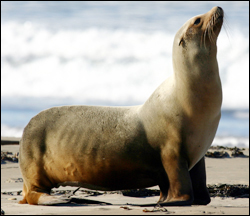
Back flipper of a "walking" sea lion. Photographer - Mike Baird.
License - Creative Commons Attribution-Noncommercial 2.0 Generic
 Sea Lion skeleton
Sea Lion skeletonClick on a photo to check your answer.
It's me!
I'm a northern
elephant seal.
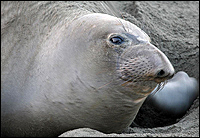
Not me.
I'm a Galapagos sea lion.
I have earflaps.

Upper image: Photographer - Michal Utin.
Lower image: Photographer - David Cook.
Licenses - Creative Commons Attribution-Noncommercial 2.0 Generic
The two species of elephant seals

There are two living species of elephant seals, the northern elephant seal, Mirounga angustirostris and the southern elephant seal, Mirounga leonina. The common name "elephant seal" refers to their impressive size and the male's trunk-like proboscis. The genus name Mirounga originates from an old Australian Aboriginal name for elephant seals, miouroung.
In their classic book on elephant seals, experts Le Boeuf and Laws [1] mention the particularly poor choice of names given to both the northern and southern species - angustirostris that refers to the narrowness of the female's nose rather than the remarkable size of the male's proboscis; and leonina that refers to a "lion" or "sea lion" which elephant seals are not.
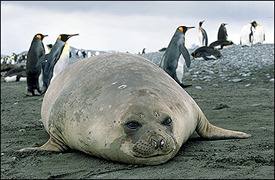 Female southern elephant seal Mirounga leonina
at Salisbury Plain (South Georgia and the South Sandwich Islands).
Gerald and Buff Corsi © California Academy of Sciences.
Female southern elephant seal Mirounga leonina
at Salisbury Plain (South Georgia and the South Sandwich Islands).
Gerald and Buff Corsi © California Academy of Sciences.
Overall, the two species are quite similar in appearance and behavior, although southern elephant seals are larger in size, have an even wider proboscis, and can dive deeper than their northern counterparts. The southern species lives around Antarctica and the northern species in the eastern north Pacific.
Males and females are so different in size and appearance that they may not be recognized as members of the same species. The differences in form between females and males of the same species is called sexual dimorphism. Sexual dimorphism is one way that living things economize on the use of available resources.
Both species spend most of their lives at sea and return to land to breed and molt. Breeding colonies in the north include the beaches of California and Baja California. Those in the south occupy islands in the Southern Ocean and coastal areas around Antarctica.
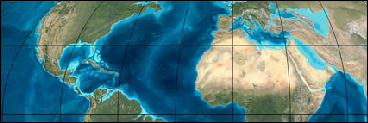 Reconstruction of the world during the Miocene (20 million years before the present).
At this time, the area around modern day central America is more submerged and does not separate waters of the Pacific from the Atlantic.
Map courtesy Ron Blakey.
Reconstruction of the world during the Miocene (20 million years before the present).
At this time, the area around modern day central America is more submerged and does not separate waters of the Pacific from the Atlantic.
Map courtesy Ron Blakey.
Both species are thought to have originated from monachinoid seals that made their way from the Atlantic into the Pacific about 15 to 20 million years ago when the barrier between the two oceans was open across central America. Which species developed first and how they became separated between the two hemispheres is not known.
Distribution of elephant seal breeding colonies around the world today. Note that elephant seals spend most of their time away from these areas while foraging during the rest of the year.


